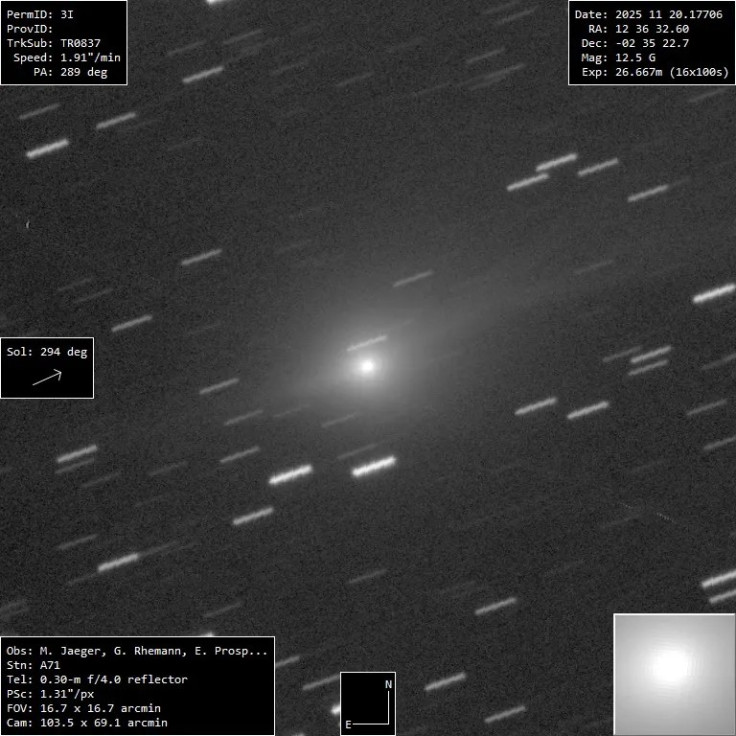Mini‑Objects Are Escaping 3I/ATLAS As New Data Suggests Break‑Up In Progress
New observations show fragments separating from 3I/ATLAS, hinting at an active disintegration underway in deep space

A striking new image of the interstellar object 3I/ATLAS has deepened scientific intrigue after astronomers reported evidence of narrow, X-shaped jets that may indicate the object is breaking apart.
Captured on 20 November 2025 by astrophotographers M. Jäger, G. Rhemann and E. Prosperi, the observation shows features that defy standard comet behaviour and raises the possibility that mini-objects are now escaping from the nucleus.
As researchers debate natural versus extraordinary explanations, 3I/ATLAS continues to exhibit behaviour unlike that of any comet observed in our solar system.
New Image Reveals Unusual X-Shaped Jets
The latest observation, reported by independent astronomers, stacked 20 exposures of 100 seconds each at 4:15 UTC. The displayed field covers 16.7 arcminutes, equivalent to 1.6 million kilometres at 3I/ATLAS' distance of 326 million kilometres from Earth.
The image reveals two narrow jets extending in opposite directions, oriented vertically to the 3I/ATLAS–Sun axis. Together with the tail and anti‑tail along the axis, the features form an X‑shaped pattern stretching nearly a million kilometres outward.
The simplest explanation is that the lines are satellite streaks that happen to intersect the field of view. A third streak near the bottom of the image supports this possibility. However, if future images confirm the jets are real, they raise profound questions about the nature of 3I/ATLAS.
Scientific Puzzles Challenge Conventional Comet Models
Two puzzles stand out. First, the jets are unusually straight and narrow, resembling thin lines. Given that 3I/ATLAS rotates every 16.16 hours, scientists expected periodic gaps or wiggles in the jets due to thermal speeds of around 400 metres per second for sublimated volatiles. Yet no such features appear.
Second, the jets are oriented vertically to the Sun's axis. Outgassing typically occurs on the sunlit side of a comet, with radiation pressure and the solar wind pushing material along the Sun–object axis. The vertical jets defy this expectation, suggesting an alternative mechanism.
Are Mini-Objects Escaping From the Nucleus?
If not satellite streaks, the jets may trace the paths of mini‑objects departing from 3I/ATLAS. Calculations suggest that if these fragments began their journey near perihelion on 29 October 2025, they would have travelled a million kilometres in 22 days at speeds of about 500 metres per second relative to the nucleus.
These mini‑objects could be natural ice fragments breaking off under thermal stress. Alternatively, some researchers speculate they could be small probes released from a technological mothership. Monitoring their trajectories in the coming weeks will be critical to distinguishing between natural and artificial origins.
Earlier Mars Encounter Hinted at Break-Up

The HiRISE camera aboard NASA's Mars Reconnaissance Orbiter captured a similar X‑pattern on 2 October 2025, when 3I/ATLAS was near Mars. That image showed jets extending only a few thousand kilometres, suggesting the early stages of fragmentation.
If the break‑up began near Mars, the ejection speed of sub‑components would need to be about 200 metres per second. This velocity kick, known as Delta‑V in rocketry, is consistent with chemical propulsion but too strong to be explained by the Sun's tidal forces.
Human Inspiration Amid Scientific Uncertainty
Beyond the science, 3I/ATLAS has sparked profound personal responses. Letters sent to Dr Loeb highlight how the mystery has inspired curiosity and courage.
One reader from Missouri described how, after discovering her daughter, she pursued a new career in anthropology. Another, an attorney from Florida's Space Coast, praised Loeb's evidence‑based openness as a counter to declining public trust in science.
These testimonies underscore how interstellar discoveries resonate far beyond academia, igniting wonder and reshaping lives.
The fundamental question remains: are the smaller objects real, and if so, are they natural fragments or technological artefacts? Upcoming observations will be decisive. If confirmed, 3I/ATLAS's break‑up could provide unprecedented insights into interstellar material or open the door to even more extraordinary interpretations.
For now, astronomers and the public alike are united in anticipation, watching as 3I/ATLAS continues its enigmatic journey through the solar system.
© Copyright IBTimes 2025. All rights reserved.



















